Leadership Self-Assessment Report: Analysis of Leadership Styles
VerifiedAdded on 2020/03/07
|10
|2632
|70
Report
AI Summary
This report presents a comprehensive leadership self-assessment, analyzing the results of three different assessment tools: the Leadership Assessment Team Leadership Styles Profile, the Credibility Assessment, and the Leadership self-assessment Personal Style Inventory. The student explores their leadership potential, identifying strengths such as effective thinking skills, extroversion, and collaborative tendencies. The report also highlights areas for improvement, such as expertise in specific areas and inconsistencies in collaborative leadership styles across different assessment tools. Furthermore, the report compares and contrasts the results from each self-assessment, revealing both similarities and differences in the student's leadership characteristics. The analysis extends to a concise discussion of transformational and trait-based leadership styles, comparing and contrasting their roles, behaviors, and capabilities. The student utilizes this analysis to understand the strengths and weaknesses of each leadership style and how they relate to their own leadership potential. The report concludes by emphasizing the importance of self-awareness and continuous development in becoming an effective leader.
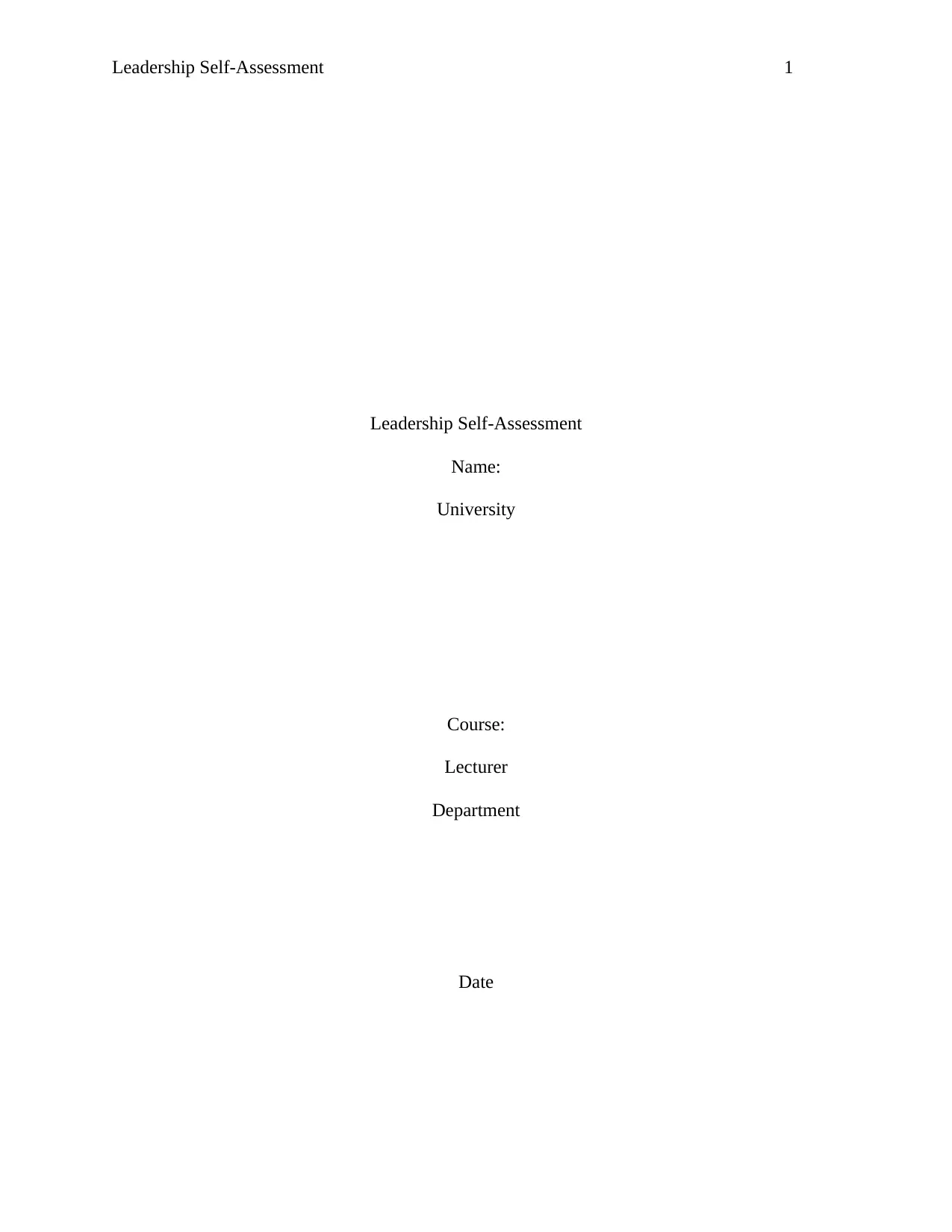
Leadership Self-Assessment 1
Leadership Self-Assessment
Name:
University
Course:
Lecturer
Department
Date
Leadership Self-Assessment
Name:
University
Course:
Lecturer
Department
Date
Paraphrase This Document
Need a fresh take? Get an instant paraphrase of this document with our AI Paraphraser
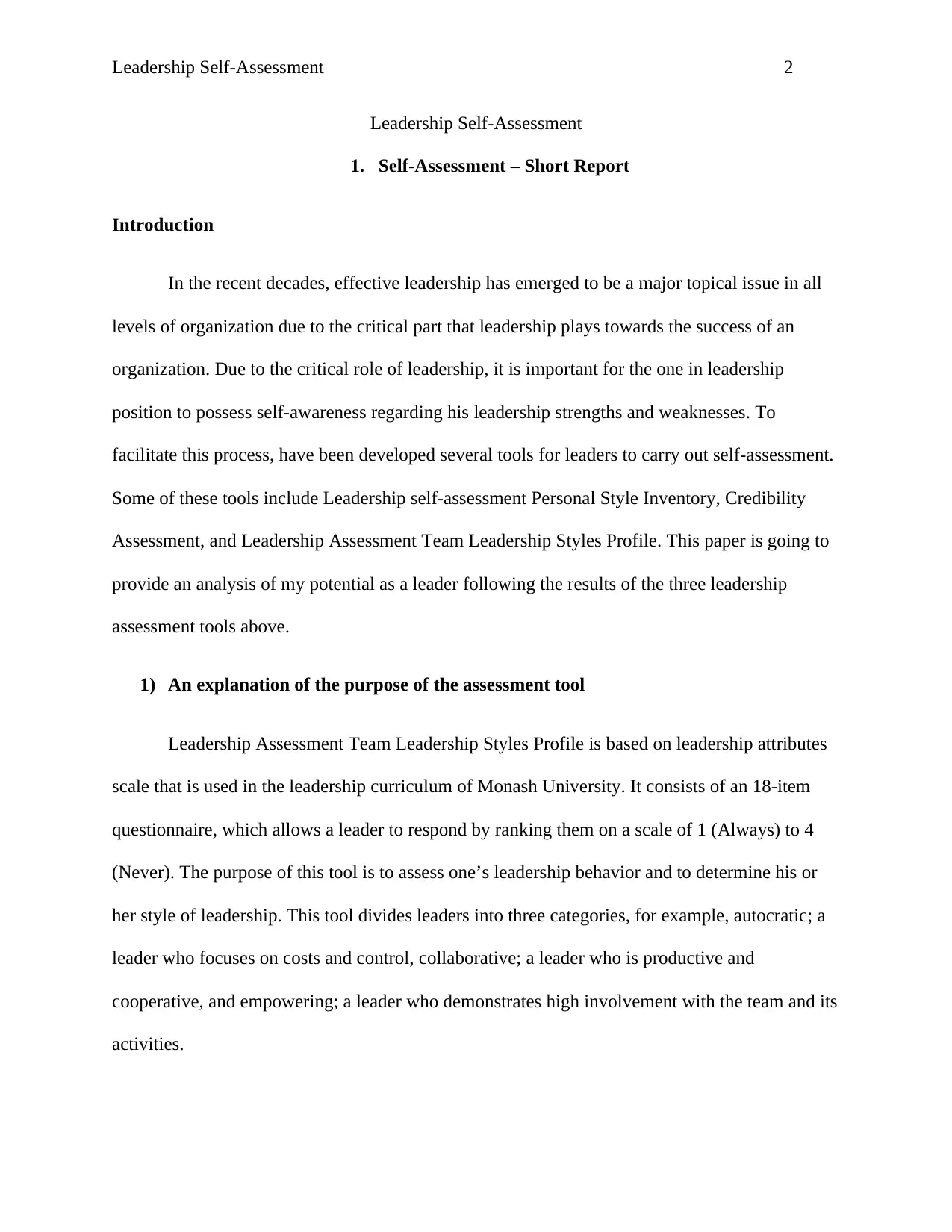
Leadership Self-Assessment 2
Leadership Self-Assessment
1. Self-Assessment – Short Report
Introduction
In the recent decades, effective leadership has emerged to be a major topical issue in all
levels of organization due to the critical part that leadership plays towards the success of an
organization. Due to the critical role of leadership, it is important for the one in leadership
position to possess self-awareness regarding his leadership strengths and weaknesses. To
facilitate this process, have been developed several tools for leaders to carry out self-assessment.
Some of these tools include Leadership self-assessment Personal Style Inventory, Credibility
Assessment, and Leadership Assessment Team Leadership Styles Profile. This paper is going to
provide an analysis of my potential as a leader following the results of the three leadership
assessment tools above.
1) An explanation of the purpose of the assessment tool
Leadership Assessment Team Leadership Styles Profile is based on leadership attributes
scale that is used in the leadership curriculum of Monash University. It consists of an 18-item
questionnaire, which allows a leader to respond by ranking them on a scale of 1 (Always) to 4
(Never). The purpose of this tool is to assess one’s leadership behavior and to determine his or
her style of leadership. This tool divides leaders into three categories, for example, autocratic; a
leader who focuses on costs and control, collaborative; a leader who is productive and
cooperative, and empowering; a leader who demonstrates high involvement with the team and its
activities.
Leadership Self-Assessment
1. Self-Assessment – Short Report
Introduction
In the recent decades, effective leadership has emerged to be a major topical issue in all
levels of organization due to the critical part that leadership plays towards the success of an
organization. Due to the critical role of leadership, it is important for the one in leadership
position to possess self-awareness regarding his leadership strengths and weaknesses. To
facilitate this process, have been developed several tools for leaders to carry out self-assessment.
Some of these tools include Leadership self-assessment Personal Style Inventory, Credibility
Assessment, and Leadership Assessment Team Leadership Styles Profile. This paper is going to
provide an analysis of my potential as a leader following the results of the three leadership
assessment tools above.
1) An explanation of the purpose of the assessment tool
Leadership Assessment Team Leadership Styles Profile is based on leadership attributes
scale that is used in the leadership curriculum of Monash University. It consists of an 18-item
questionnaire, which allows a leader to respond by ranking them on a scale of 1 (Always) to 4
(Never). The purpose of this tool is to assess one’s leadership behavior and to determine his or
her style of leadership. This tool divides leaders into three categories, for example, autocratic; a
leader who focuses on costs and control, collaborative; a leader who is productive and
cooperative, and empowering; a leader who demonstrates high involvement with the team and its
activities.
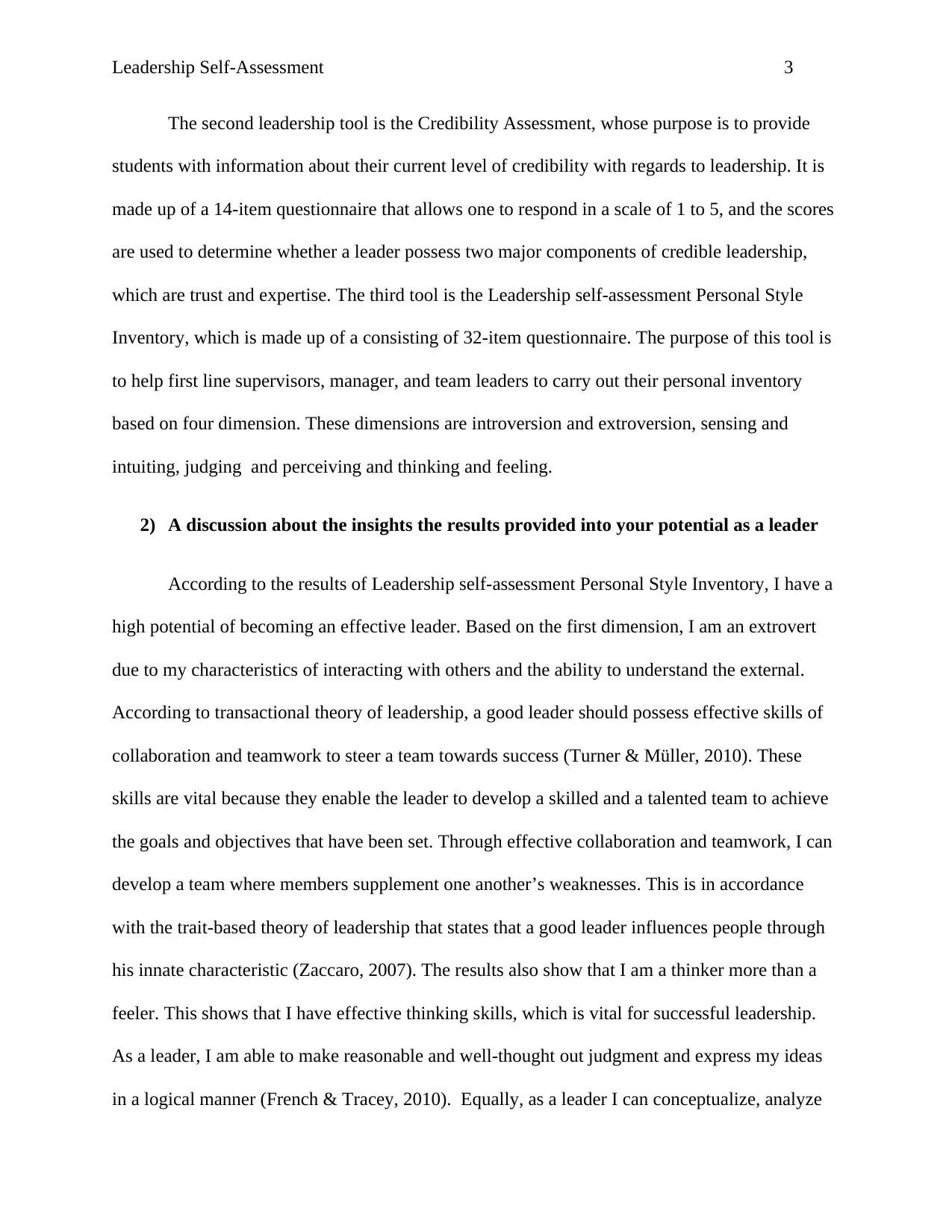
Leadership Self-Assessment 3
The second leadership tool is the Credibility Assessment, whose purpose is to provide
students with information about their current level of credibility with regards to leadership. It is
made up of a 14-item questionnaire that allows one to respond in a scale of 1 to 5, and the scores
are used to determine whether a leader possess two major components of credible leadership,
which are trust and expertise. The third tool is the Leadership self-assessment Personal Style
Inventory, which is made up of a consisting of 32-item questionnaire. The purpose of this tool is
to help first line supervisors, manager, and team leaders to carry out their personal inventory
based on four dimension. These dimensions are introversion and extroversion, sensing and
intuiting, judging and perceiving and thinking and feeling.
2) A discussion about the insights the results provided into your potential as a leader
According to the results of Leadership self-assessment Personal Style Inventory, I have a
high potential of becoming an effective leader. Based on the first dimension, I am an extrovert
due to my characteristics of interacting with others and the ability to understand the external.
According to transactional theory of leadership, a good leader should possess effective skills of
collaboration and teamwork to steer a team towards success (Turner & Müller, 2010). These
skills are vital because they enable the leader to develop a skilled and a talented team to achieve
the goals and objectives that have been set. Through effective collaboration and teamwork, I can
develop a team where members supplement one another’s weaknesses. This is in accordance
with the trait-based theory of leadership that states that a good leader influences people through
his innate characteristic (Zaccaro, 2007). The results also show that I am a thinker more than a
feeler. This shows that I have effective thinking skills, which is vital for successful leadership.
As a leader, I am able to make reasonable and well-thought out judgment and express my ideas
in a logical manner (French & Tracey, 2010). Equally, as a leader I can conceptualize, analyze
The second leadership tool is the Credibility Assessment, whose purpose is to provide
students with information about their current level of credibility with regards to leadership. It is
made up of a 14-item questionnaire that allows one to respond in a scale of 1 to 5, and the scores
are used to determine whether a leader possess two major components of credible leadership,
which are trust and expertise. The third tool is the Leadership self-assessment Personal Style
Inventory, which is made up of a consisting of 32-item questionnaire. The purpose of this tool is
to help first line supervisors, manager, and team leaders to carry out their personal inventory
based on four dimension. These dimensions are introversion and extroversion, sensing and
intuiting, judging and perceiving and thinking and feeling.
2) A discussion about the insights the results provided into your potential as a leader
According to the results of Leadership self-assessment Personal Style Inventory, I have a
high potential of becoming an effective leader. Based on the first dimension, I am an extrovert
due to my characteristics of interacting with others and the ability to understand the external.
According to transactional theory of leadership, a good leader should possess effective skills of
collaboration and teamwork to steer a team towards success (Turner & Müller, 2010). These
skills are vital because they enable the leader to develop a skilled and a talented team to achieve
the goals and objectives that have been set. Through effective collaboration and teamwork, I can
develop a team where members supplement one another’s weaknesses. This is in accordance
with the trait-based theory of leadership that states that a good leader influences people through
his innate characteristic (Zaccaro, 2007). The results also show that I am a thinker more than a
feeler. This shows that I have effective thinking skills, which is vital for successful leadership.
As a leader, I am able to make reasonable and well-thought out judgment and express my ideas
in a logical manner (French & Tracey, 2010). Equally, as a leader I can conceptualize, analyze
⊘ This is a preview!⊘
Do you want full access?
Subscribe today to unlock all pages.

Trusted by 1+ million students worldwide
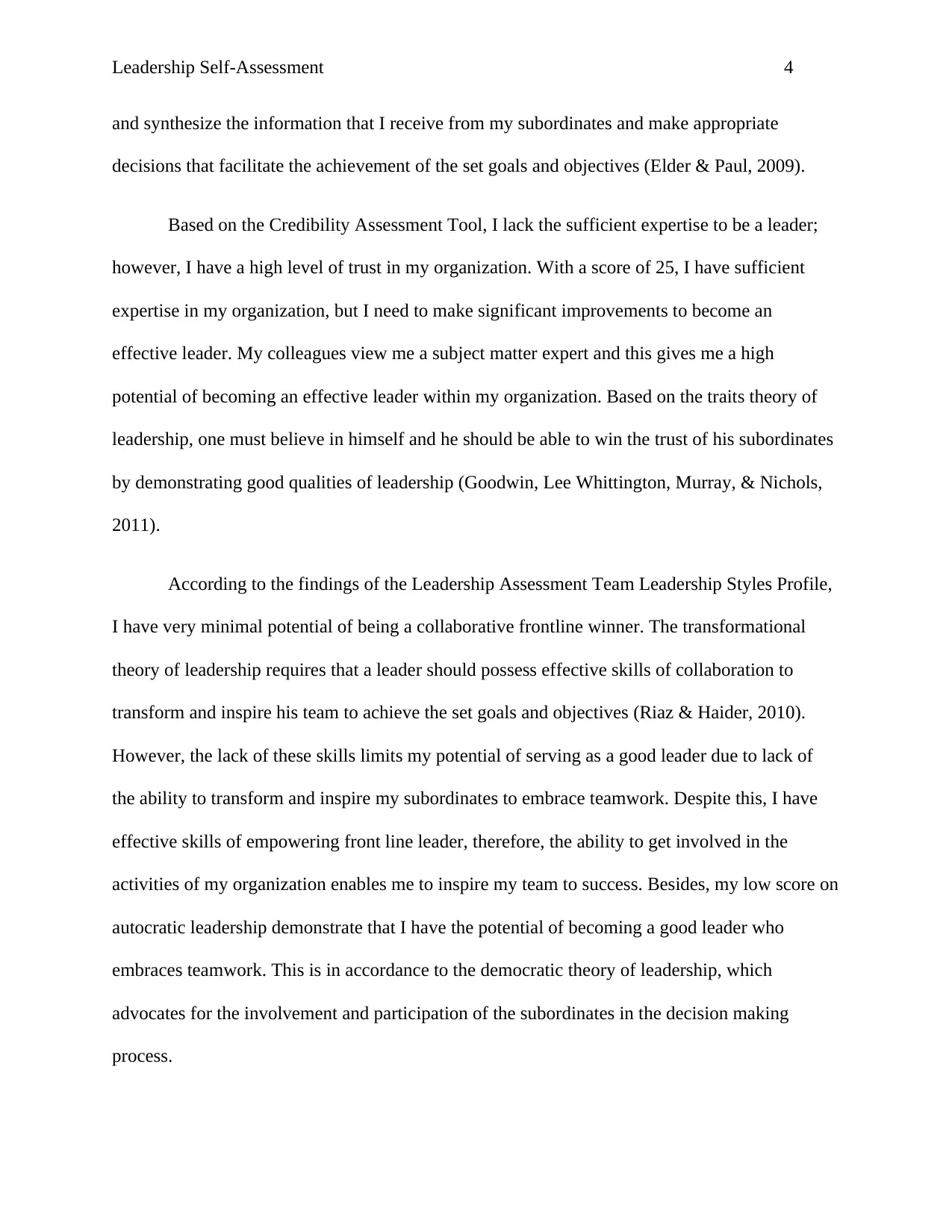
Leadership Self-Assessment 4
and synthesize the information that I receive from my subordinates and make appropriate
decisions that facilitate the achievement of the set goals and objectives (Elder & Paul, 2009).
Based on the Credibility Assessment Tool, I lack the sufficient expertise to be a leader;
however, I have a high level of trust in my organization. With a score of 25, I have sufficient
expertise in my organization, but I need to make significant improvements to become an
effective leader. My colleagues view me a subject matter expert and this gives me a high
potential of becoming an effective leader within my organization. Based on the traits theory of
leadership, one must believe in himself and he should be able to win the trust of his subordinates
by demonstrating good qualities of leadership (Goodwin, Lee Whittington, Murray, & Nichols,
2011).
According to the findings of the Leadership Assessment Team Leadership Styles Profile,
I have very minimal potential of being a collaborative frontline winner. The transformational
theory of leadership requires that a leader should possess effective skills of collaboration to
transform and inspire his team to achieve the set goals and objectives (Riaz & Haider, 2010).
However, the lack of these skills limits my potential of serving as a good leader due to lack of
the ability to transform and inspire my subordinates to embrace teamwork. Despite this, I have
effective skills of empowering front line leader, therefore, the ability to get involved in the
activities of my organization enables me to inspire my team to success. Besides, my low score on
autocratic leadership demonstrate that I have the potential of becoming a good leader who
embraces teamwork. This is in accordance to the democratic theory of leadership, which
advocates for the involvement and participation of the subordinates in the decision making
process.
and synthesize the information that I receive from my subordinates and make appropriate
decisions that facilitate the achievement of the set goals and objectives (Elder & Paul, 2009).
Based on the Credibility Assessment Tool, I lack the sufficient expertise to be a leader;
however, I have a high level of trust in my organization. With a score of 25, I have sufficient
expertise in my organization, but I need to make significant improvements to become an
effective leader. My colleagues view me a subject matter expert and this gives me a high
potential of becoming an effective leader within my organization. Based on the traits theory of
leadership, one must believe in himself and he should be able to win the trust of his subordinates
by demonstrating good qualities of leadership (Goodwin, Lee Whittington, Murray, & Nichols,
2011).
According to the findings of the Leadership Assessment Team Leadership Styles Profile,
I have very minimal potential of being a collaborative frontline winner. The transformational
theory of leadership requires that a leader should possess effective skills of collaboration to
transform and inspire his team to achieve the set goals and objectives (Riaz & Haider, 2010).
However, the lack of these skills limits my potential of serving as a good leader due to lack of
the ability to transform and inspire my subordinates to embrace teamwork. Despite this, I have
effective skills of empowering front line leader, therefore, the ability to get involved in the
activities of my organization enables me to inspire my team to success. Besides, my low score on
autocratic leadership demonstrate that I have the potential of becoming a good leader who
embraces teamwork. This is in accordance to the democratic theory of leadership, which
advocates for the involvement and participation of the subordinates in the decision making
process.
Paraphrase This Document
Need a fresh take? Get an instant paraphrase of this document with our AI Paraphraser
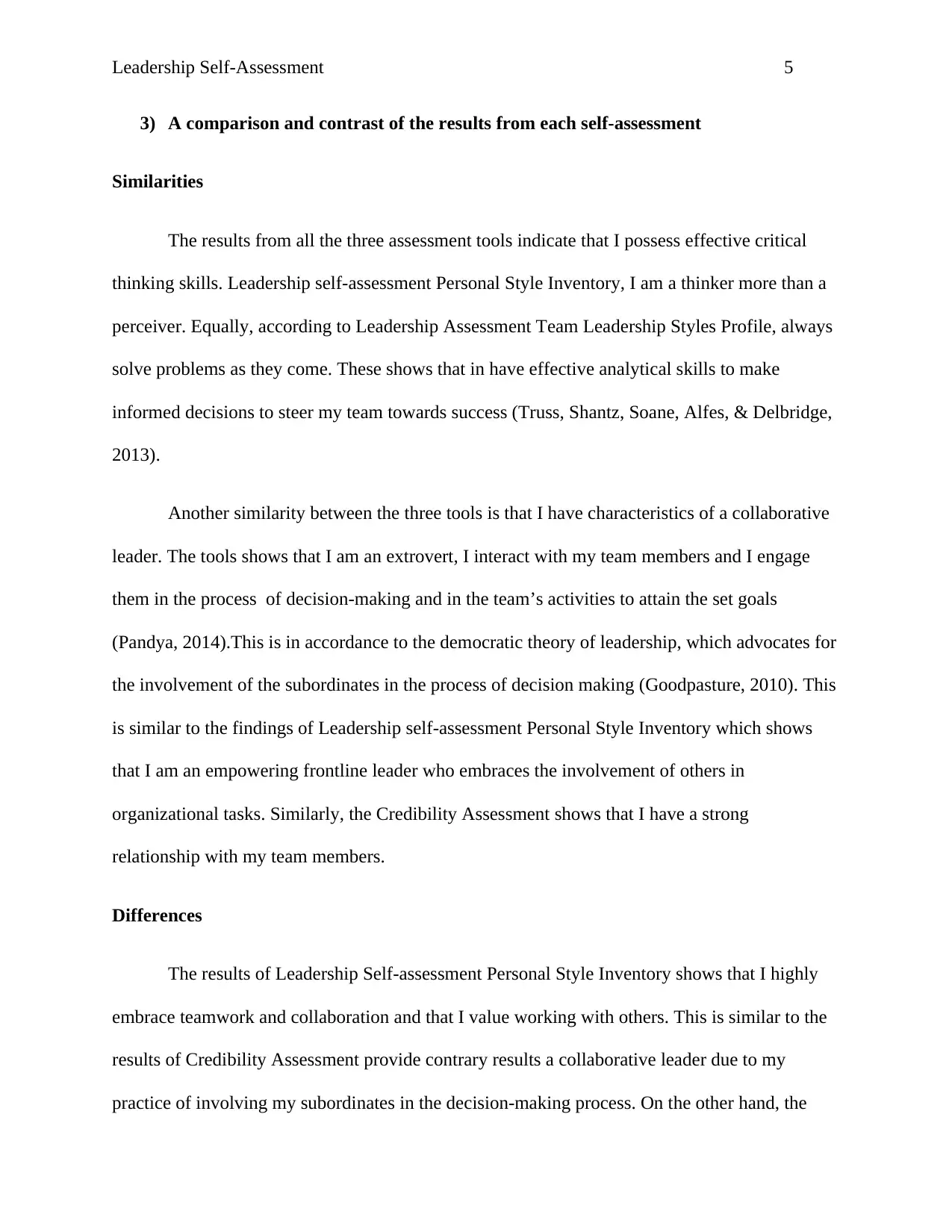
Leadership Self-Assessment 5
3) A comparison and contrast of the results from each self-assessment
Similarities
The results from all the three assessment tools indicate that I possess effective critical
thinking skills. Leadership self-assessment Personal Style Inventory, I am a thinker more than a
perceiver. Equally, according to Leadership Assessment Team Leadership Styles Profile, always
solve problems as they come. These shows that in have effective analytical skills to make
informed decisions to steer my team towards success (Truss, Shantz, Soane, Alfes, & Delbridge,
2013).
Another similarity between the three tools is that I have characteristics of a collaborative
leader. The tools shows that I am an extrovert, I interact with my team members and I engage
them in the process of decision-making and in the team’s activities to attain the set goals
(Pandya, 2014).This is in accordance to the democratic theory of leadership, which advocates for
the involvement of the subordinates in the process of decision making (Goodpasture, 2010). This
is similar to the findings of Leadership self-assessment Personal Style Inventory which shows
that I am an empowering frontline leader who embraces the involvement of others in
organizational tasks. Similarly, the Credibility Assessment shows that I have a strong
relationship with my team members.
Differences
The results of Leadership Self-assessment Personal Style Inventory shows that I highly
embrace teamwork and collaboration and that I value working with others. This is similar to the
results of Credibility Assessment provide contrary results a collaborative leader due to my
practice of involving my subordinates in the decision-making process. On the other hand, the
3) A comparison and contrast of the results from each self-assessment
Similarities
The results from all the three assessment tools indicate that I possess effective critical
thinking skills. Leadership self-assessment Personal Style Inventory, I am a thinker more than a
perceiver. Equally, according to Leadership Assessment Team Leadership Styles Profile, always
solve problems as they come. These shows that in have effective analytical skills to make
informed decisions to steer my team towards success (Truss, Shantz, Soane, Alfes, & Delbridge,
2013).
Another similarity between the three tools is that I have characteristics of a collaborative
leader. The tools shows that I am an extrovert, I interact with my team members and I engage
them in the process of decision-making and in the team’s activities to attain the set goals
(Pandya, 2014).This is in accordance to the democratic theory of leadership, which advocates for
the involvement of the subordinates in the process of decision making (Goodpasture, 2010). This
is similar to the findings of Leadership self-assessment Personal Style Inventory which shows
that I am an empowering frontline leader who embraces the involvement of others in
organizational tasks. Similarly, the Credibility Assessment shows that I have a strong
relationship with my team members.
Differences
The results of Leadership Self-assessment Personal Style Inventory shows that I highly
embrace teamwork and collaboration and that I value working with others. This is similar to the
results of Credibility Assessment provide contrary results a collaborative leader due to my
practice of involving my subordinates in the decision-making process. On the other hand, the
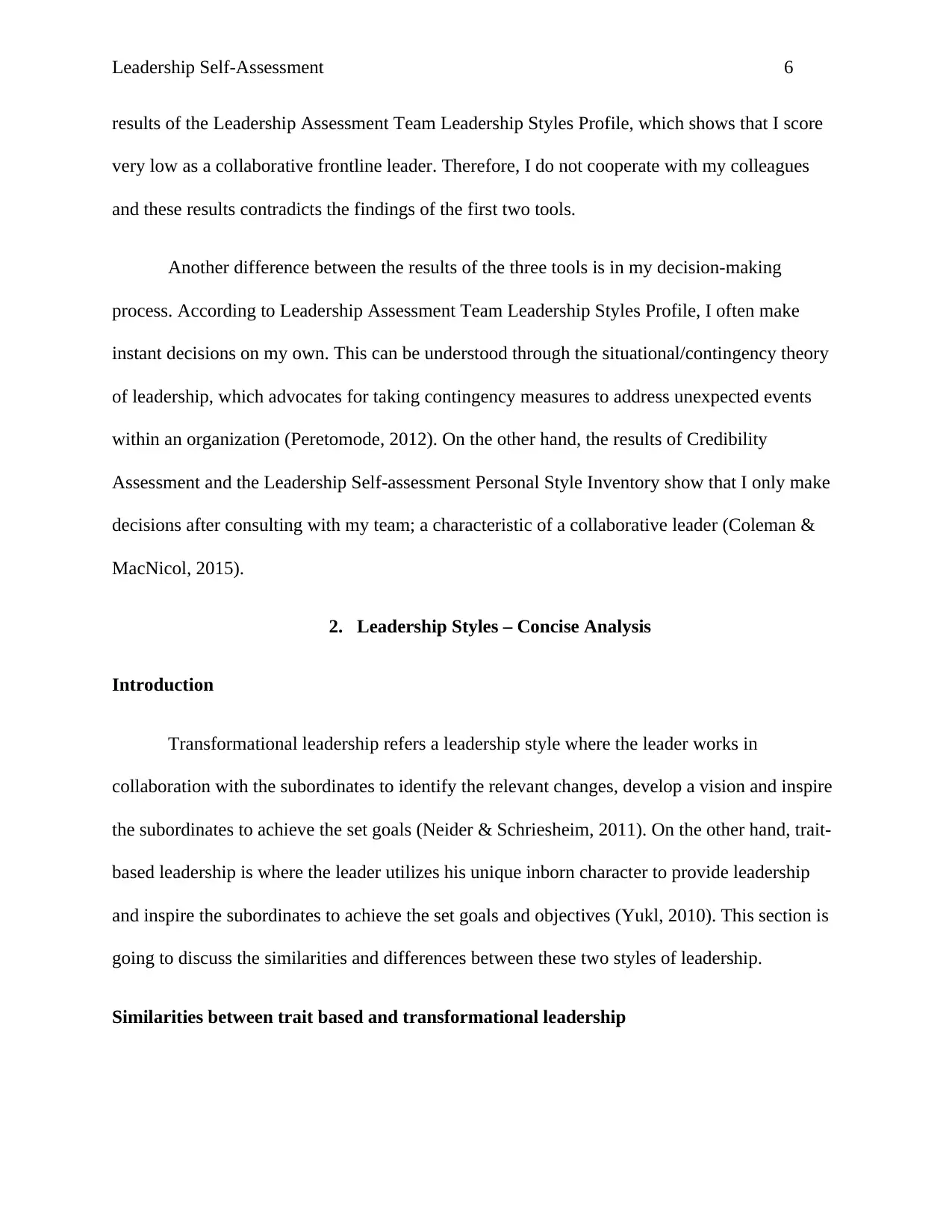
Leadership Self-Assessment 6
results of the Leadership Assessment Team Leadership Styles Profile, which shows that I score
very low as a collaborative frontline leader. Therefore, I do not cooperate with my colleagues
and these results contradicts the findings of the first two tools.
Another difference between the results of the three tools is in my decision-making
process. According to Leadership Assessment Team Leadership Styles Profile, I often make
instant decisions on my own. This can be understood through the situational/contingency theory
of leadership, which advocates for taking contingency measures to address unexpected events
within an organization (Peretomode, 2012). On the other hand, the results of Credibility
Assessment and the Leadership Self-assessment Personal Style Inventory show that I only make
decisions after consulting with my team; a characteristic of a collaborative leader (Coleman &
MacNicol, 2015).
2. Leadership Styles – Concise Analysis
Introduction
Transformational leadership refers a leadership style where the leader works in
collaboration with the subordinates to identify the relevant changes, develop a vision and inspire
the subordinates to achieve the set goals (Neider & Schriesheim, 2011). On the other hand, trait-
based leadership is where the leader utilizes his unique inborn character to provide leadership
and inspire the subordinates to achieve the set goals and objectives (Yukl, 2010). This section is
going to discuss the similarities and differences between these two styles of leadership.
Similarities between trait based and transformational leadership
results of the Leadership Assessment Team Leadership Styles Profile, which shows that I score
very low as a collaborative frontline leader. Therefore, I do not cooperate with my colleagues
and these results contradicts the findings of the first two tools.
Another difference between the results of the three tools is in my decision-making
process. According to Leadership Assessment Team Leadership Styles Profile, I often make
instant decisions on my own. This can be understood through the situational/contingency theory
of leadership, which advocates for taking contingency measures to address unexpected events
within an organization (Peretomode, 2012). On the other hand, the results of Credibility
Assessment and the Leadership Self-assessment Personal Style Inventory show that I only make
decisions after consulting with my team; a characteristic of a collaborative leader (Coleman &
MacNicol, 2015).
2. Leadership Styles – Concise Analysis
Introduction
Transformational leadership refers a leadership style where the leader works in
collaboration with the subordinates to identify the relevant changes, develop a vision and inspire
the subordinates to achieve the set goals (Neider & Schriesheim, 2011). On the other hand, trait-
based leadership is where the leader utilizes his unique inborn character to provide leadership
and inspire the subordinates to achieve the set goals and objectives (Yukl, 2010). This section is
going to discuss the similarities and differences between these two styles of leadership.
Similarities between trait based and transformational leadership
⊘ This is a preview!⊘
Do you want full access?
Subscribe today to unlock all pages.

Trusted by 1+ million students worldwide
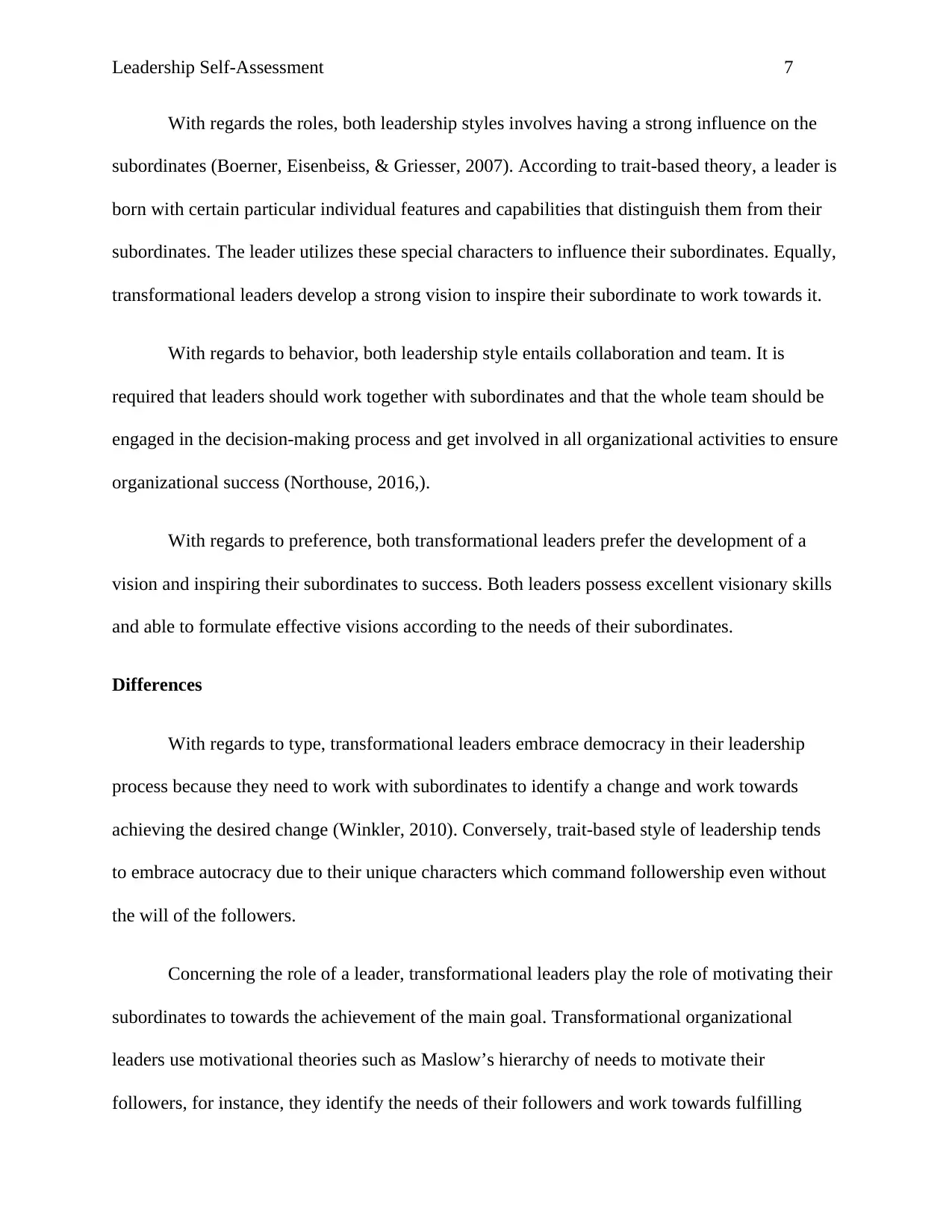
Leadership Self-Assessment 7
With regards the roles, both leadership styles involves having a strong influence on the
subordinates (Boerner, Eisenbeiss, & Griesser, 2007). According to trait-based theory, a leader is
born with certain particular individual features and capabilities that distinguish them from their
subordinates. The leader utilizes these special characters to influence their subordinates. Equally,
transformational leaders develop a strong vision to inspire their subordinate to work towards it.
With regards to behavior, both leadership style entails collaboration and team. It is
required that leaders should work together with subordinates and that the whole team should be
engaged in the decision-making process and get involved in all organizational activities to ensure
organizational success (Northouse, 2016,).
With regards to preference, both transformational leaders prefer the development of a
vision and inspiring their subordinates to success. Both leaders possess excellent visionary skills
and able to formulate effective visions according to the needs of their subordinates.
Differences
With regards to type, transformational leaders embrace democracy in their leadership
process because they need to work with subordinates to identify a change and work towards
achieving the desired change (Winkler, 2010). Conversely, trait-based style of leadership tends
to embrace autocracy due to their unique characters which command followership even without
the will of the followers.
Concerning the role of a leader, transformational leaders play the role of motivating their
subordinates to towards the achievement of the main goal. Transformational organizational
leaders use motivational theories such as Maslow’s hierarchy of needs to motivate their
followers, for instance, they identify the needs of their followers and work towards fulfilling
With regards the roles, both leadership styles involves having a strong influence on the
subordinates (Boerner, Eisenbeiss, & Griesser, 2007). According to trait-based theory, a leader is
born with certain particular individual features and capabilities that distinguish them from their
subordinates. The leader utilizes these special characters to influence their subordinates. Equally,
transformational leaders develop a strong vision to inspire their subordinate to work towards it.
With regards to behavior, both leadership style entails collaboration and team. It is
required that leaders should work together with subordinates and that the whole team should be
engaged in the decision-making process and get involved in all organizational activities to ensure
organizational success (Northouse, 2016,).
With regards to preference, both transformational leaders prefer the development of a
vision and inspiring their subordinates to success. Both leaders possess excellent visionary skills
and able to formulate effective visions according to the needs of their subordinates.
Differences
With regards to type, transformational leaders embrace democracy in their leadership
process because they need to work with subordinates to identify a change and work towards
achieving the desired change (Winkler, 2010). Conversely, trait-based style of leadership tends
to embrace autocracy due to their unique characters which command followership even without
the will of the followers.
Concerning the role of a leader, transformational leaders play the role of motivating their
subordinates to towards the achievement of the main goal. Transformational organizational
leaders use motivational theories such as Maslow’s hierarchy of needs to motivate their
followers, for instance, they identify the needs of their followers and work towards fulfilling
Paraphrase This Document
Need a fresh take? Get an instant paraphrase of this document with our AI Paraphraser
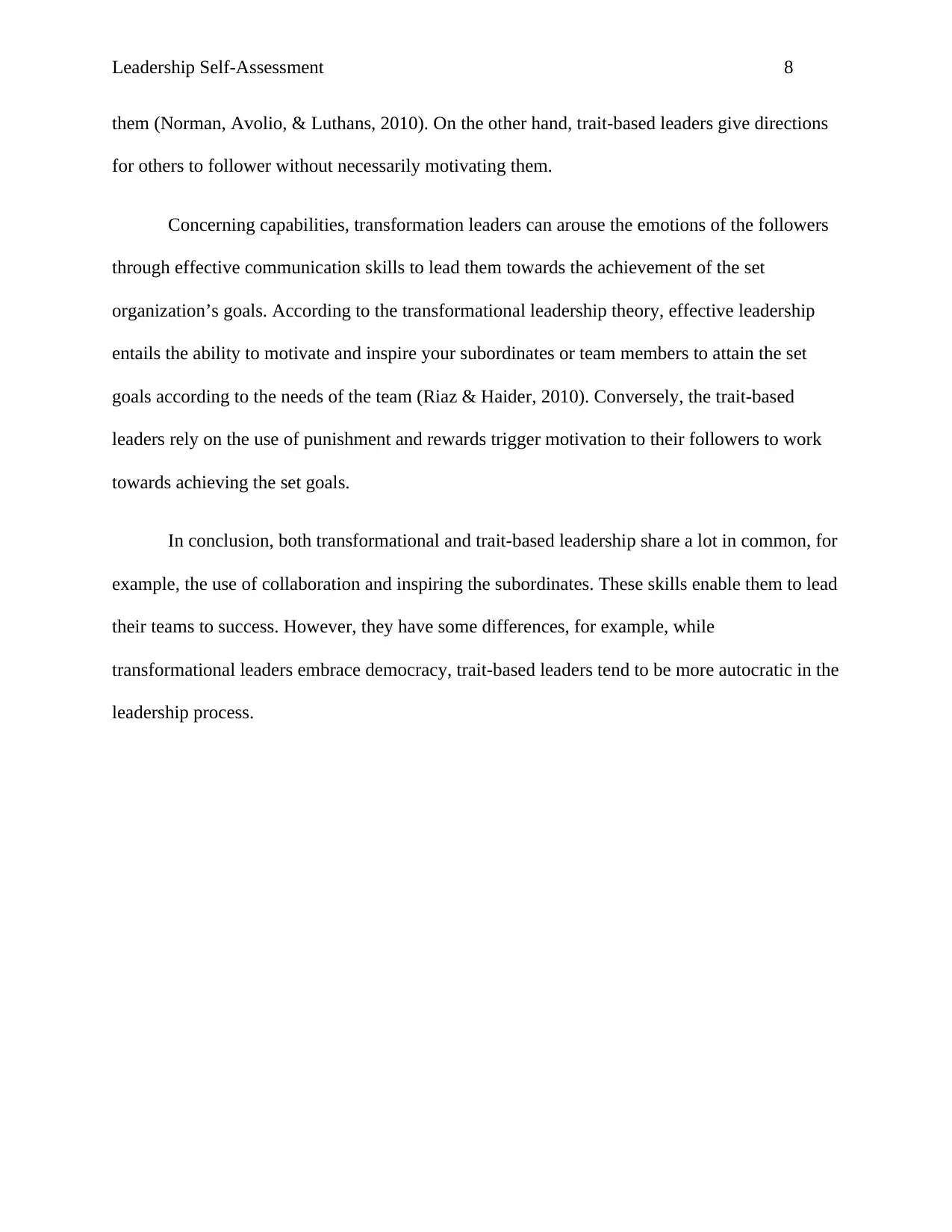
Leadership Self-Assessment 8
them (Norman, Avolio, & Luthans, 2010). On the other hand, trait-based leaders give directions
for others to follower without necessarily motivating them.
Concerning capabilities, transformation leaders can arouse the emotions of the followers
through effective communication skills to lead them towards the achievement of the set
organization’s goals. According to the transformational leadership theory, effective leadership
entails the ability to motivate and inspire your subordinates or team members to attain the set
goals according to the needs of the team (Riaz & Haider, 2010). Conversely, the trait-based
leaders rely on the use of punishment and rewards trigger motivation to their followers to work
towards achieving the set goals.
In conclusion, both transformational and trait-based leadership share a lot in common, for
example, the use of collaboration and inspiring the subordinates. These skills enable them to lead
their teams to success. However, they have some differences, for example, while
transformational leaders embrace democracy, trait-based leaders tend to be more autocratic in the
leadership process.
them (Norman, Avolio, & Luthans, 2010). On the other hand, trait-based leaders give directions
for others to follower without necessarily motivating them.
Concerning capabilities, transformation leaders can arouse the emotions of the followers
through effective communication skills to lead them towards the achievement of the set
organization’s goals. According to the transformational leadership theory, effective leadership
entails the ability to motivate and inspire your subordinates or team members to attain the set
goals according to the needs of the team (Riaz & Haider, 2010). Conversely, the trait-based
leaders rely on the use of punishment and rewards trigger motivation to their followers to work
towards achieving the set goals.
In conclusion, both transformational and trait-based leadership share a lot in common, for
example, the use of collaboration and inspiring the subordinates. These skills enable them to lead
their teams to success. However, they have some differences, for example, while
transformational leaders embrace democracy, trait-based leaders tend to be more autocratic in the
leadership process.
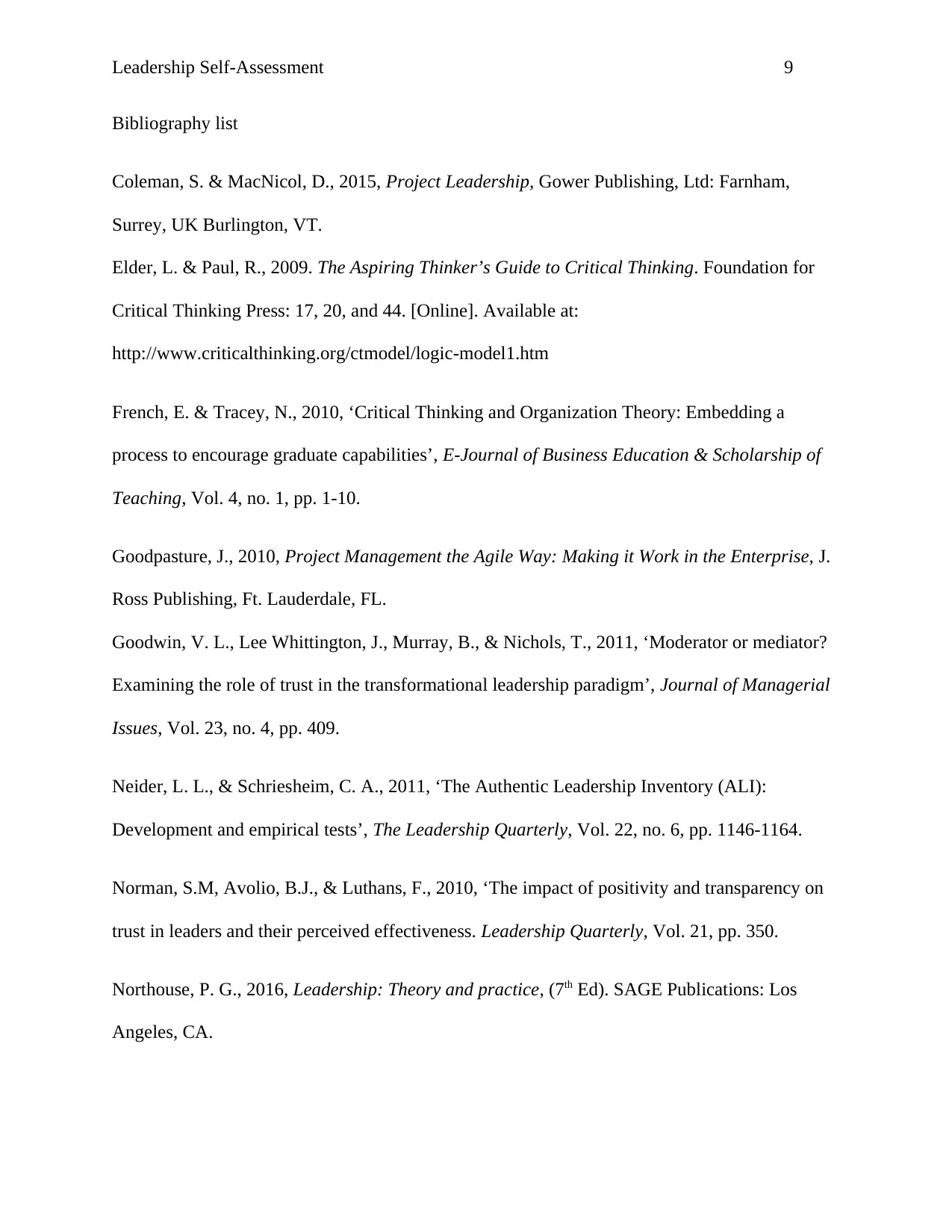
Leadership Self-Assessment 9
Bibliography list
Coleman, S. & MacNicol, D., 2015, Project Leadership, Gower Publishing, Ltd: Farnham,
Surrey, UK Burlington, VT.
Elder, L. & Paul, R., 2009. The Aspiring Thinker’s Guide to Critical Thinking. Foundation for
Critical Thinking Press: 17, 20, and 44. [Online]. Available at:
http://www.criticalthinking.org/ctmodel/logic-model1.htm
French, E. & Tracey, N., 2010, ‘Critical Thinking and Organization Theory: Embedding a
process to encourage graduate capabilities’, E-Journal of Business Education & Scholarship of
Teaching, Vol. 4, no. 1, pp. 1-10.
Goodpasture, J., 2010, Project Management the Agile Way: Making it Work in the Enterprise, J.
Ross Publishing, Ft. Lauderdale, FL.
Goodwin, V. L., Lee Whittington, J., Murray, B., & Nichols, T., 2011, ‘Moderator or mediator?
Examining the role of trust in the transformational leadership paradigm’, Journal of Managerial
Issues, Vol. 23, no. 4, pp. 409.
Neider, L. L., & Schriesheim, C. A., 2011, ‘The Authentic Leadership Inventory (ALI):
Development and empirical tests’, The Leadership Quarterly, Vol. 22, no. 6, pp. 1146-1164.
Norman, S.M, Avolio, B.J., & Luthans, F., 2010, ‘The impact of positivity and transparency on
trust in leaders and their perceived effectiveness. Leadership Quarterly, Vol. 21, pp. 350.
Northouse, P. G., 2016, Leadership: Theory and practice, (7th Ed). SAGE Publications: Los
Angeles, CA.
Bibliography list
Coleman, S. & MacNicol, D., 2015, Project Leadership, Gower Publishing, Ltd: Farnham,
Surrey, UK Burlington, VT.
Elder, L. & Paul, R., 2009. The Aspiring Thinker’s Guide to Critical Thinking. Foundation for
Critical Thinking Press: 17, 20, and 44. [Online]. Available at:
http://www.criticalthinking.org/ctmodel/logic-model1.htm
French, E. & Tracey, N., 2010, ‘Critical Thinking and Organization Theory: Embedding a
process to encourage graduate capabilities’, E-Journal of Business Education & Scholarship of
Teaching, Vol. 4, no. 1, pp. 1-10.
Goodpasture, J., 2010, Project Management the Agile Way: Making it Work in the Enterprise, J.
Ross Publishing, Ft. Lauderdale, FL.
Goodwin, V. L., Lee Whittington, J., Murray, B., & Nichols, T., 2011, ‘Moderator or mediator?
Examining the role of trust in the transformational leadership paradigm’, Journal of Managerial
Issues, Vol. 23, no. 4, pp. 409.
Neider, L. L., & Schriesheim, C. A., 2011, ‘The Authentic Leadership Inventory (ALI):
Development and empirical tests’, The Leadership Quarterly, Vol. 22, no. 6, pp. 1146-1164.
Norman, S.M, Avolio, B.J., & Luthans, F., 2010, ‘The impact of positivity and transparency on
trust in leaders and their perceived effectiveness. Leadership Quarterly, Vol. 21, pp. 350.
Northouse, P. G., 2016, Leadership: Theory and practice, (7th Ed). SAGE Publications: Los
Angeles, CA.
⊘ This is a preview!⊘
Do you want full access?
Subscribe today to unlock all pages.

Trusted by 1+ million students worldwide
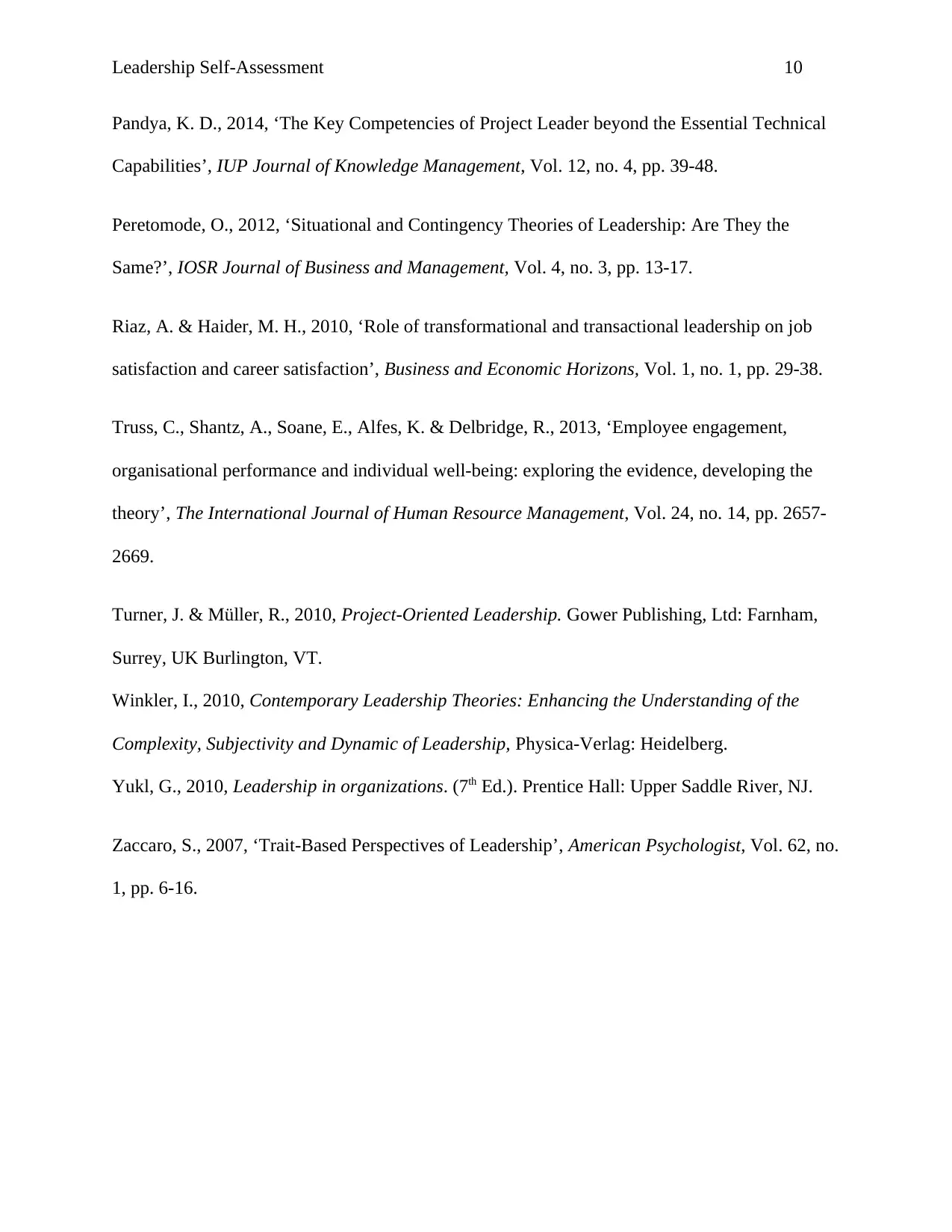
Leadership Self-Assessment 10
Pandya, K. D., 2014, ‘The Key Competencies of Project Leader beyond the Essential Technical
Capabilities’, IUP Journal of Knowledge Management, Vol. 12, no. 4, pp. 39-48.
Peretomode, O., 2012, ‘Situational and Contingency Theories of Leadership: Are They the
Same?’, IOSR Journal of Business and Management, Vol. 4, no. 3, pp. 13-17.
Riaz, A. & Haider, M. H., 2010, ‘Role of transformational and transactional leadership on job
satisfaction and career satisfaction’, Business and Economic Horizons, Vol. 1, no. 1, pp. 29-38.
Truss, C., Shantz, A., Soane, E., Alfes, K. & Delbridge, R., 2013, ‘Employee engagement,
organisational performance and individual well-being: exploring the evidence, developing the
theory’, The International Journal of Human Resource Management, Vol. 24, no. 14, pp. 2657-
2669.
Turner, J. & Müller, R., 2010, Project-Oriented Leadership. Gower Publishing, Ltd: Farnham,
Surrey, UK Burlington, VT.
Winkler, I., 2010, Contemporary Leadership Theories: Enhancing the Understanding of the
Complexity, Subjectivity and Dynamic of Leadership, Physica-Verlag: Heidelberg.
Yukl, G., 2010, Leadership in organizations. (7th Ed.). Prentice Hall: Upper Saddle River, NJ.
Zaccaro, S., 2007, ‘Trait-Based Perspectives of Leadership’, American Psychologist, Vol. 62, no.
1, pp. 6-16.
Pandya, K. D., 2014, ‘The Key Competencies of Project Leader beyond the Essential Technical
Capabilities’, IUP Journal of Knowledge Management, Vol. 12, no. 4, pp. 39-48.
Peretomode, O., 2012, ‘Situational and Contingency Theories of Leadership: Are They the
Same?’, IOSR Journal of Business and Management, Vol. 4, no. 3, pp. 13-17.
Riaz, A. & Haider, M. H., 2010, ‘Role of transformational and transactional leadership on job
satisfaction and career satisfaction’, Business and Economic Horizons, Vol. 1, no. 1, pp. 29-38.
Truss, C., Shantz, A., Soane, E., Alfes, K. & Delbridge, R., 2013, ‘Employee engagement,
organisational performance and individual well-being: exploring the evidence, developing the
theory’, The International Journal of Human Resource Management, Vol. 24, no. 14, pp. 2657-
2669.
Turner, J. & Müller, R., 2010, Project-Oriented Leadership. Gower Publishing, Ltd: Farnham,
Surrey, UK Burlington, VT.
Winkler, I., 2010, Contemporary Leadership Theories: Enhancing the Understanding of the
Complexity, Subjectivity and Dynamic of Leadership, Physica-Verlag: Heidelberg.
Yukl, G., 2010, Leadership in organizations. (7th Ed.). Prentice Hall: Upper Saddle River, NJ.
Zaccaro, S., 2007, ‘Trait-Based Perspectives of Leadership’, American Psychologist, Vol. 62, no.
1, pp. 6-16.
1 out of 10
Related Documents
Your All-in-One AI-Powered Toolkit for Academic Success.
+13062052269
info@desklib.com
Available 24*7 on WhatsApp / Email
![[object Object]](/_next/static/media/star-bottom.7253800d.svg)
Unlock your academic potential
Copyright © 2020–2025 A2Z Services. All Rights Reserved. Developed and managed by ZUCOL.




